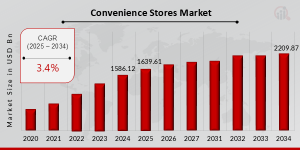Convenience Stores Market Size, Share, Trends, Growth Opportunities, Key Players and Forecast to 2034
Convenience Stores Market Research Report By, Product Type, Ownership Type, Store Size, Target Consumer, Regional
VT, UNITED STATES, August 7, 2025 /EINPresswire.com/ -- The global Convenience Stores Market has experienced steady growth and continues to expand as consumer demand for quick and easy retail access rises. In 2024, the market size was estimated at USD 1586.12 billion and is projected to grow from USD 1639.61 billion in 2025 to reach USD 2209.87 billion by 2034, at a compound annual growth rate (CAGR) of 3.34% during the forecast period (2025–2034). The market growth is driven by evolving consumer lifestyles, urbanization, and the rising demand for ready-to-eat and on-the-go products.Key Market Drivers
1. Changing Urban Lifestyles
Increasing urbanization and fast-paced lifestyles have led to a shift in consumer preference toward quick, hassle-free shopping. Convenience stores cater to these needs by offering round-the-clock services, strategic locations, and curated product assortments.
2. Rise in Ready-to-Eat and Packaged Foods
There is growing demand for ready-to-eat meals, snacks, and beverages, especially among millennials and working professionals. Convenience stores are capitalizing on this trend by expanding their food service offerings and refrigerated/frozen food sections.
3. Expansion of Retail Infrastructure
Retail giants and regional players are expanding their footprint through franchise models and partnerships. The convenience store format is increasingly being adopted in both urban and suburban areas to meet rising demand.
4. Integration of Technology in Store Operations
Digital POS systems, mobile payment solutions, loyalty programs, and self-checkout kiosks are enhancing customer experience. Tech-enabled inventory tracking and AI-based demand forecasting are improving operational efficiency.
Get a FREE Sample Report - https://www.marketresearchfuture.com/sample_request/22842
Market Challenges
1. High Competition from Supermarkets and Online Retail
While convenience stores offer fast service, they face stiff competition from supermarkets with broader inventories and e-commerce platforms that offer home delivery.
2. Supply Chain Disruptions and Operational Costs
Maintaining fresh inventory and ensuring smooth supply chains pose challenges, especially during geopolitical disruptions or economic downturns. Additionally, operating costs including rent and utilities remain a concern in urban centers.
Browse In-depth Market Research Report: https://www.marketresearchfuture.com/reports/convenience-stores-market-22842
Key Companies in the Convenience Stores Market
• 7-Eleven, Inc.
• Alimentation Couche-Tard Inc.
• FamilyMart Co., Ltd.
• Lawson, Inc.
• The Kroger Co.
• SPAR International
• GS Retail Co., Ltd.
• Casey's General Stores, Inc.
• Tesco PLC
• Sainsbury's Local
• Amazon Go
• Reliance Smart Point
• Easyday (Future Retail)
• Ministop Co., Ltd.
• Bharat Petroleum In & Out
These players are focusing on digital transformation, strategic acquisitions, and private label product expansion to stay competitive in a dynamic retail environment.
Market Segmentation
1. By Store Type
• Traditional Convenience Stores: Small format stores with a focus on essentials.
• Hyper Convenience Stores: Larger footprint, extended product categories.
• Automated/Micro Stores: Unmanned or tech-integrated retail pods.
2. By Product Category
• Food & Beverages: Snacks, dairy, frozen food, ready-to-eat items.
• Grocery Essentials: Toiletries, cleaning products, and packaged goods.
• Alcohol and Tobacco: Common in certain regional markets.
• Personal Care & OTC Drugs: Rapidly growing category.
• Others: Newspapers, electronics accessories, seasonal goods.
3. By Ownership
• Franchise-Owned
• Company-Owned
• Independent Retailers
4. By Sales Channel
• Offline/In-Store: Dominates the market with physical locations.
• Online Ordering & Delivery: Rapidly emerging through partnerships with delivery aggregators.
5. By Region
• North America: Mature market with strong brand presence.
• Europe: Focused on high-quality private label and local products.
• Asia-Pacific: Fastest-growing market due to population density and urban sprawl.
• Middle East & Africa: Increasing adoption of franchise models.
• Latin America: Expansion of modern retail formats driving growth.
Procure Complete Research Report Now: https://www.marketresearchfuture.com/checkout?currency=one_user-USD&report_id=22842
The Convenience Stores Market is expected to continue its stable upward trajectory, supported by consumer trends favoring fast, accessible retail solutions. With advancements in digital retail tech, increasing product diversification, and expansion into tier 2 and 3 cities globally, the sector presents substantial opportunities for both incumbents and new entrants over the next decade.
Related Reports:
Financial Cloud Market
Motorcycle Insurance Market
CMS Financial Earns 2025-2026 Great Place To Work Certification™
CMS Prime Earns 2025-2026 Great Place to Work® Certification - New Milestone for CMS Prime
Intercultural Connections Awards 2025 Announces Winners at the Edinburgh Festival Fringe
Więcej ważnych informacji
 Jedynka Newserii
Jedynka Newserii

 Jedynka Newserii
Jedynka Newserii

Farmacja

Nowy pakiet farmaceutyczny ma wyrównać szanse pacjentów w całej Unii. W Polsce na niektóre leki czeka się ponad dwa lata dłużej niż w Niemczech
Jeszcze pod przewodnictwem Polski Rada UE uzgodniła stanowisko w sprawie pakietu farmaceutycznego – największej reformy prawa lekowego od 20 lat. Ma on skrócić różnice w dostępie do terapii między krajami członkowskimi, które dziś sięgają nawet dwóch–trzech lat. W Unii Europejskiej wciąż brakuje terapii na ponad 6 tys. chorób rzadkich, a niedobory obejmują również leki ratujące życie. Nowe przepisy mają zapewnić szybszy dostęp do leków, wzmocnić konkurencyjność branży oraz zabezpieczyć dostawy.
Handel
Wzrost wydobycia ropy naftowej nie wpłynie na spadek cen surowca. Kierowcy jesienią zapłacą więcej za olej napędowy

Sierpień jest trzecim z rzędu miesiącem, gdy osiem krajów OPEC+ zwiększa podaż ropy naftowej na globalnym rynku; we wrześniu nastąpi kolejna zwyżka. Kraje OPEC, zwłaszcza Arabia Saudyjska, chcą w ten sposób odzyskać udziały w rynku utracone na skutek zmniejszenia wydobycia od 2022 roku, głównie na rzecz amerykańskich producentów. Nie należy się jednak spodziewać spadku cen ropy, gdyż popyt powinien być wysoki, a pod znakiem zapytania stoi dostępność ropy z Rosji. Nie zmienia to faktu, że jesienią ceny paliw na stacjach zazwyczaj rosną, a w największym stopniu podwyżki dotyczyć będą diesla.
Nauka
Szacowanie rzeczywistej liczby użytkowników miast dużym wyzwaniem. Statystycy wykorzystują dane z nowoczesnych źródeł

Różnica między liczbą rezydentów a rzeczywistą liczbą osób codziennie przebywających w Warszawie może sięgać nawet niemal pół miliona. Rozbieżności są dostrzegalne przede wszystkim w dużych miastach i ich obszarach funkcjonalnych. Precyzyjne dane populacyjne są tymczasem niezbędne w kształtowaniu usług społecznych i zdrowotnych, edukacyjnych, opiekuńczych, a także w planowaniu inwestycji infrastrukturalnych. W statystyce coraz częściej dane z oficjalnych źródeł, takich jak Zakład Ubezpieczeń Społecznych, są uzupełniane o te pochodzące od operatorów sieci komórkowych czy kart płatniczych.
Partner serwisu
Szkolenia

Akademia Newserii
Akademia Newserii to projekt, w ramach którego najlepsi polscy dziennikarze biznesowi, giełdowi oraz lifestylowi, a także szkoleniowcy z wieloletnim doświadczeniem dzielą się swoją wiedzą nt. pracy z mediami.









.gif)

 |
| |
| |
|